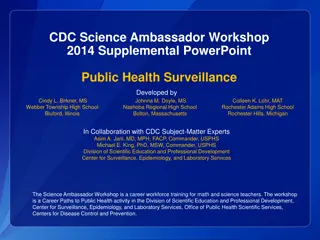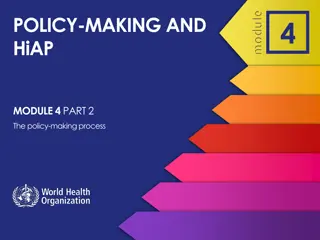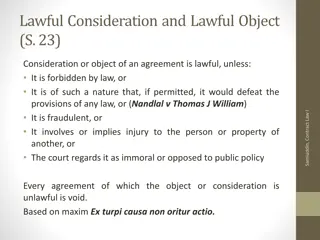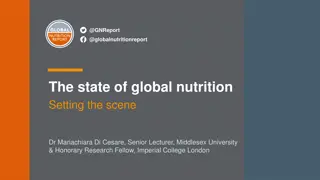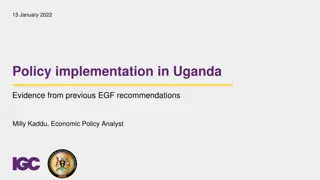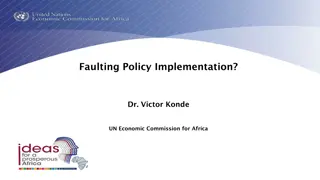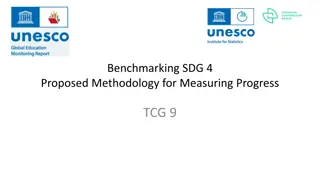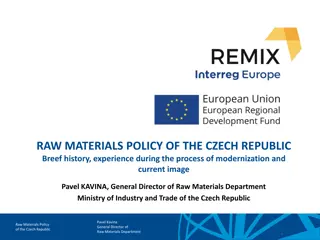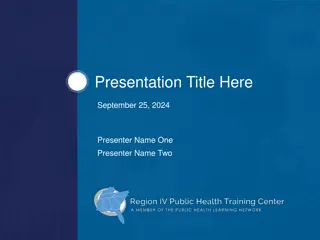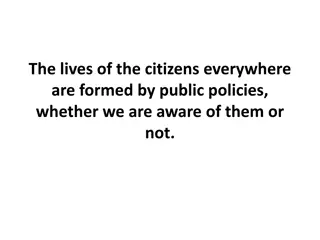Global Public Health Progress and IP Policy Challenges
Widened global awareness and increased funding have improved access to treatments for public health issues. However, politicized IP policies and stakeholder conflicts pose challenges. Case studies from India and South Africa highlight the importance of balanced intellectual property regulations in the pharmaceutical industry.
Download Presentation

Please find below an Image/Link to download the presentation.
The content on the website is provided AS IS for your information and personal use only. It may not be sold, licensed, or shared on other websites without obtaining consent from the author.If you encounter any issues during the download, it is possible that the publisher has removed the file from their server.
You are allowed to download the files provided on this website for personal or commercial use, subject to the condition that they are used lawfully. All files are the property of their respective owners.
The content on the website is provided AS IS for your information and personal use only. It may not be sold, licensed, or shared on other websites without obtaining consent from the author.
E N D
Presentation Transcript
Welcome Presentation on DNA Fingerprinting and Relevant Techniques [For M.Sc. I, Institutional Learning Management System] Presentation by
Content Forensic Science and DNA fingerprinting Invention of DNA fingerprinting Preparation of DNA Fingerprint Steps of DNA fingerprinting Types of Analysis RFLP, PCR, STR Analysis, AFLP Analysis Applications
DNA Fingerprinting and Forensic Science Forensic science Intersection of Law and Science Historic examples of collecting evidences: 18th Century Photography Early 19th Century Fingerprints From 1985 DNA Fingerprinting Unique signature found in each person s genetic makeup Obsolete & Can Be Manipulated
Invention of DNA Fingerprinting Invented by Alec Jeffreys at the University of Leicester in 1985.
DNA Fingerprinting Different from Full Genome Sequencing DNA Typing DNA Profiling DNA Testing DNA Fingerprinting
DNA Fingerprinting DNA profiles are: Small set of DNA variations To identify individuals of same species Employed by Forensic Scientists
Biological materials used for DNA profiling Blood (extracted, dry or wet, WBC, etc) Hair (roots) Saliva Semen (wet or dried, can be analyzed years later) Body tissue cells Skin cells Buccal (cheek cells)
Preparing a DNA Profile Pattern Pattern Analysis Denaturing Temperature of DNA is 52-55 oC
Blotting & Hybridization A common laboratory procedure in which biological molecules in a gel matrix are transferred onto nitrocellulose paper for further scientific analysis is called as Blotting The process of making complementary strand of our own interest is called as Hybridization a radioactive
Types of DNA Fingerprinting DNA Profiling depends upon Restriction Fragment Length Polymorphism (RFLP) Requires larger amounts of DNA DNA is not degraded
Types of DNA Fingerprinting Polymerase Chain Reaction (PCR) Requires less DNA DNA can be partially degraded Extremely sensitive to contamination obtain billions of replicates. This process is called a Polymerase Chain Reaction (PCR). In the PCR process, the DNA sample is denatured into the separate individual polynucleotide strands through heating. A single copy of a DNA strand can be amplified to
Types of DNA Fingerprinting Problem with PCR: Highly degraded DNA (very small samples) may cause allelic dropout or other stochastic effects. Very high number repeats may bunch together at the top of the gel, making it difficult to resolve.
Exons, Introns and VNTRs DNA profiling depends on a small segment of the genome Exons are functional genes and code proteins (constitutes 48 %) Introns are non functional genes and do not code proteins (constitutes 52 %) Introns contain repeated sequences of base pairs, ranging between 1 and 100 are Called variable number tandem repeats (VNTR s) Some VNTRs are inherited from parents (mother and some from father)
Microsatellite and Short Tandem Repeats (STR) DNA Fingerprinting Short Tandem Repeats (Probe ) Microsatellite (Unique Sequence)
Microsatellite and Short Tandem Repeats Microsatellite 1 to 6 nucleotide repeats dispersed throughout the chromosomes are called as Microsatellites. Probes (complementary sequence)used to identify the microsatellite is called as Short Tandem Repeats (STR) . STR surrounds the specific microsatellite being analyzed.
Microsatellite and Short Tandem Repeats DNA fingerprinting is restricted to the detection of microsatellites. Federal Bureau of Investigation (FBI) has selected 13 unique STRs for DNA testing. The Combined DNA Index System (CODIS) blends forensic science and computer technology into a tool for linking violent crimes.
Amplified fragment length polymorphism (AFLP Analysis) Into practice from early 1990s (now highly automated) Low Cost Easy Set-up Faster than RFLP AFLP Relied on VNTRs Polymorphisms (to distinguish various alleles.) Easy Creation of Phylogenetic Trees (comparing individual samples of DNA) Bands are separated on Polyacrylamide Gels and visualized by Silver Staining.
Comparison of Types of DNA Fingerprinting Particular Method RFLP Older (80 s) PCR AFLP Newer method (90 s) More sensitive Can use degraded DNA from minute sources Simultaneous analysis of many genes Latest method (90 s) Sensitivity Amount Less Requires large amount of high quality DNA One gene analyzed at a time Most sensitive Only PCR amplified product Gene Analyzed At a time analysis of many genes for comparison of their Degree of Expression (comparative analysis of expressed genes) Note: Expression of genes means the genes gives their decided products such as proteins or enzymes
Comparison of Types of DNA Fingerprinting Particular Labor RFLP PCR AFLP Intensive High throughput After getting PCR product very less Faster: 3-5 hours Single test Analysis Time Tests Needed Slow: 7-10 days Fewer individual tests needed Genes examined have >100 alleles Fast: 2-6 days More individual tests needed Genes examined have between 10-15 alleles No. of Alleles for Genes Examined Whole genome can be analyzed e.g. Human Genome Project Highest Power of Discrimination High Low
Applications DNA profiling is used to solve crimes and medical problems (parental disputes) Forensic science is the use of scientific knowledge in legal situations Reunited kid lost in tsunami with parents To identify bodies of solders killed in war To discriminate DNA of human and animals To solve problem of migrants in UK
References https://en.wikipedia.org/wiki/DNA_profiling https://www.webmd.com/a-to-z-guides/dna- fingerprinting-overview https://www.webmd.com/a-to-z-guides/dna- fingerprinting-overview#1 https://www.britannica.com/science/DNA- fingerprinting Encyclopedia of Analytical Chemistry
Dr. Kundan Chandramani Tayade, Rajarshi Shahu Mahavidyalaya (Autonomous), Latur.




